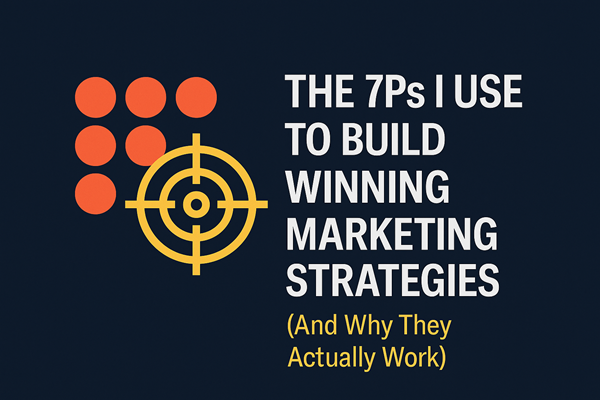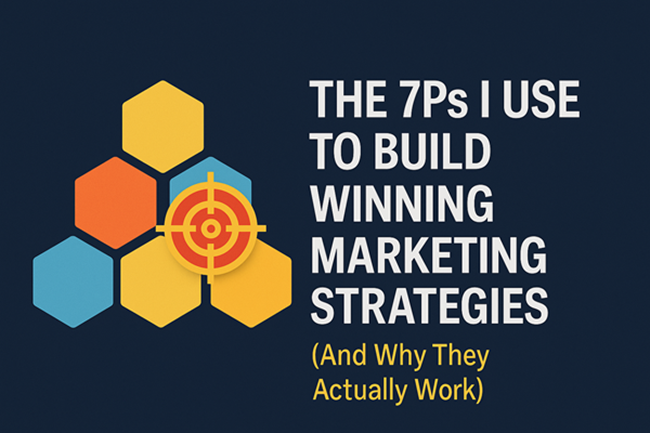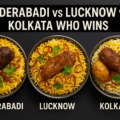Let’s be honest—marketing frameworks often feel like academic checklists that belong more in classrooms than in the chaos of real business. But the 7Ps of marketing? They’ve been my secret weapon. Not as a rigid structure, but as a living, breathing strategy model I turn to when launching new campaigns, repositioning products, or auditing brand performance.
Let me walk you through how I actually use each “P” in the trenches—no jargon, no fluff—just what works.

7Ps of Marketing Are :
1. Product: Nail the Problem You Solve
Every product is a promise. And if that promise isn’t clear, compelling, or connected to a real-world problem—marketing can’t save it.
When I work with product teams, I ask one key question: “What transformation does your customer experience after using this?” If we can’t answer that in one sentence, we’re not ready for market.
Here’s what works:
- Deep user research (not just surveys—actual conversations)
- Real differentiation—What makes us meaningfully better?
- Continuous feedback loops post-launch
Pro tip: Don’t get romantic about your product. Let data and customer conversations shape it.
2. Price: It’s More Than a Number
Pricing has never just been about covering costs. It’s storytelling. It’s positioning. It’s psychology.
I’ve seen teams price products low thinking they’d win on affordability—and end up losing credibility. I’ve also seen premium-priced tools with less functionality outsell everyone… simply because they owned their value.
How I handle pricing:
- Competitor and market benchmarking
- Testing different tiers with real users
- Anchoring pricing with value (not features)
A great product at the wrong price point is like a Ferrari in a fog. You’ll never see it coming.
3. Place: Be Where the Buyer Actually Is
Distribution isn’t just about selling—it’s about access. I always map out the customer journey first: Where do they hang out? Where do they research? Where do they trust recommendations?
It’s often a combination of:
- Organic search (SEO is still gold)
- Influencers and partnerships
- D2C sites, marketplaces, or even pop-ups for tactile products
In today’s world, the “place” is fluid. A product review on YouTube can drive more conversions than a store display. The goal is to show up early, often, and in the right mood.
4. Promotion: Be Relevant, or Be Ignored
Promotion isn’t about shouting louder—it’s about showing up with what matters most, in the moment they care.
I’ve led campaigns that blew budgets with zero traction because they were saying the wrong thing at the right time. And I’ve seen $500 content pieces go viral because they spoke to a core frustration.
What I’ve learned:
- Tailor messages to platform behavior. Instagram ≠ LinkedIn.
- Use data to find what actually resonates (not just what your boss thinks looks cool).
- Don’t over-rely on one channel—run omnichannel sprints.
Also, your landing page must match your promotion’s promise. Disconnect = drop-off.
5. People: The Brand Behind the Brand
I’ve always believed: People don’t just buy products—they buy the people and purpose behind them.
From your sales reps to your customer support team to your social media manager—everyone is marketing your brand.
Invest in training. Align them with your mission. Create brand storytellers, not just job-doers.
In one company I worked with, customer satisfaction spiked not because we added features—but because our support team was finally equipped to explain them properly.
Culture sells. Clarity wins.
6. Process: Consistency Creates Trust
Great marketing brings people in. But it’s great processes that keep them coming back.
Think onboarding. Think fulfillment. Think customer support.
Here’s my playbook:
- Audit every customer touchpoint. Eliminate friction.
- Systematize excellence—don’t rely on “good days” or “rockstar” staff.
- Use tech to automate without losing the human touch.
When a user’s experience is consistent—whether they buy at 2 PM or 2 AM—they’re far more likely to refer and return.
7. Physical Evidence: Build Belief Through Proof
This is the “trust factor.” The credibility you signal even before someone buys.
It could be:
- Testimonials
- Case studies
- Certifications
- Thought leadership content
- Website UX and polish
One overlooked detail? Design. A poorly designed website or pitch deck erodes trust in seconds—even if your product is stellar. Your visual identity matters.
And for physical products? Packaging is marketing. Don’t skimp on it.
My Real-World 7Ps Strategy in Action
Let me give you a quick snapshot of how I apply this in practice:
When launching a new product or campaign:
- I run a 7Ps audit: Where are the strengths? Where’s the misalignment?
- I score each “P” on impact and readiness.
- I create micro-sprints for improvement: maybe tweak pricing this week, revamp landing page next.
- Every 90 days, we review, iterate, and refresh.
The beauty of the 7Ps? It grows with you. Whether you’re a startup or scaling to global, it helps spot blind spots, align your teams, and build holistic strategies.
Final Thoughts
Frameworks don’t create magic. But when used intentionally, they clarify thinking and sharpen execution.
The 7Ps have been more than just a marketing theory for me. They’ve been a guide to building brands that resonate, convert, and endure.
Not everything will be perfect across all 7Ps at all times. But even a 10% improvement in each can snowball into major growth.
So, if you’re building something meaningful—don’t just promote louder. Market smarter. Structure deeper. And always come back to the basics that still move the needle.
Frequently Asked Questions About the 7Ps Marketing Strategy
1. What are the 7Ps of marketing?
The 7Ps stand for Product, Price, Place, Promotion, People, Process, and Physical Evidence. Together, they form a comprehensive framework to help businesses design, deliver, and refine their marketing strategy across every touchpoint of the customer journey.
2. Why is the 7Ps marketing mix important for modern businesses?
The 7Ps ensure you’re not just focused on flashy campaigns or surface-level engagement. They help you dig deeper into customer experience, pricing psychology, internal alignment, and credibility—all of which are essential for sustainable growth in today’s competitive market.
3. How do I apply the 7Ps in a digital marketing context?
In digital marketing:
- Product becomes UX and feature clarity.
- Place refers to online channels like your website, SEO, social media.
- Promotion is your content, ads, influencer marketing, and emails.
- People includes customer support teams, social media managers, etc.
- Process focuses on smooth onboarding, support, and automation flows.
- Physical Evidence includes reviews, case studies, website experience, and social proof.
4. Can small businesses or startups use the 7Ps strategy effectively?
Absolutely. In fact, startups benefit more from the 7Ps because it gives them a structured approach without requiring a massive marketing budget. Even a simple audit of the 7Ps can help you find low-hanging opportunities to improve your customer experience and conversions.
5. How often should I revisit my 7Ps strategy?
I recommend revisiting your 7Ps quarterly—especially if you’re running new campaigns, launching products, or entering new markets. Markets evolve fast, and so should your strategy.
6. What’s the difference between the 4Ps and 7Ps?
The original 4Ps of marketing (Product, Price, Place, Promotion) focused on tangible goods. As marketing matured, especially for services and digital products, the model expanded to 7Ps, adding People, Process, and Physical Evidence to reflect the full customer experience.
7. Which of the 7Ps has the most impact?
It depends on your business stage. For a new product, Product and Promotion might take the lead. In a service business, People and Process are game-changers. Ideally, they should all work together to create a seamless, trust-building experience for your customer.
For more such Digital Marketing Updates, Follow Popnewsblend.







